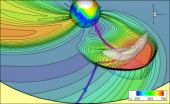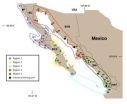(Press-News.org) ANN ARBOR, Mich. — A new study questions the controversial U.S. Preventative Service Task Force recommendations for breast cancer screening, with data that shows starting at a younger age and screening more frequently will result in more lives saved.
The study analyzed the same data looked at by the task force, which issued its guidelines on mammography screening in November 2009. The study authors compared the task force's recommendations for screening every other year in women 50-74 to American Cancer Society guidelines of screening every year in women 40-84.
The study was conducted by R. Edward Hendrick, Ph.D., clinical professor of radiology at the University of Colorado School of Medicine, and Mark Helvie, M.D., director of breast imaging at the University of Michigan Comprehensive Cancer Center. It appears in the February issue of the American Journal of Roentgenology.
Hendrick and Helvie used six model scenarios of screening mammography created by the Cancer Intervention and Surveillance Modeling Network. This is the same modeling data the task force considered. The authors compared task force guidelines to American Cancer Society guidelines.
They found that if women begin yearly mammograms at age 40, it reduces breast cancer deaths by 40 percent. When screening begins at 50 and occurs every other year, it reduces breast cancer deaths 23 percent.
The difference between these two screening strategies comes down to 71 percent more lives saved with yearly screening beginning at 40.
"Task force guidelines have created confusion among women, leading some to forego mammography altogether. Mammography is one of the few screening tools that has been proven to save lives and our analysis shows that for maximum survival, annual screening beginning at 40 is best. This data gives women more information to make an informed choice about the screening schedule that's best for them," says Helvie, professor of radiology at the U-M Medical School.
As part of their recommendation, the task force emphasized the potential harms mammography can cause – including pain during the screening exam and anxiety from false-positives, which can lead to additional imaging or biopsy.
The study authors found that on average women ages 40-49 who are screened annually will have a false-positive mammogram once every 10 years. They will get asked back for more tests once every 12 years and will undergo a false-positive biopsy once every 149 years.
"The task force overemphasized potential harms of screening mammography, while ignoring the proven statistically significant benefit of annual screening mammography starting at age 40," Hendrick says. "In addition, the panel ignored more recent data from screening programs in Sweden and Canada showing that 40 percent of breast cancer deaths are averted in women who get regular screening mammography. Our modeling results agree completely with these screening program results in terms of the large number of women lives saved by regular screening mammography."
INFORMATION:
Breast cancer statistics: 209,060 Americans will be diagnosed with breast cancer this year and 40,230 will die from the disease, according to the American Cancer Society
Reference: American Journal of Roentgenology, Vol. 196, W112-W116, February 2011
Resources:
U-M Cancer AnswerLine, 800-865-1125
University of Michigan Comprehensive Cancer Center, www.mcancer.org
University of Colorado Cancer Center, www.uccc.info
Yearly mammograms from age 40 save 71 percent more lives, study shows
Analysis questions US Task Force recommendations for every-other-year screening starting at age 50
2011-01-28
ELSE PRESS RELEASES FROM THIS DATE:
Scientists determine what makes an orangutan an orangutan
2011-01-28
For the first time, scientists have mapped the genome--the genetic code--of orangutans. This new tool may be used to support efforts to maintain the genetic diversity of captive and wild orangutans. The new map of the orangutan genome may also be used to help improve our understanding of the evolution of primates, including humans.
Partially funded by the National Science Foundation, the orangutan study appears in the Jan. 27 issue of Nature. It was conducted by an international team of scientists led by Devin P. Locke of the Genome Center at Washington University.
Conservation ...
On the hunt for universal intelligence
2011-01-28
We have developed an 'anytime' intelligence test, in other words a test that can be interrupted at any time, but that gives a more accurate idea of the intelligence of the test subject if there is a longer time available in which to carry it out", José Hernández-Orallo, a researcher at the Polytechnic University of Valencia (UPV), tells SINC.
This is just one of the many determining factors of the universal intelligence test. "The others are that it can be applied to any subject – whether biological or not – at any point in its development (child or adult, for example), ...
Study shows smaller rows contribute to more soybean yields in colder climates
2011-01-28
Madison, WI January 27, 2011 – Soybean production has continued to increase in the Northeast United States with more and more first time growers planting the crop and many experienced growers planting alongside corn crops. To save on time and expenses, some farmers plant soybeans with a corn planter in 30-inch rows instead of 7.5-inch rows with the regularly used grain drill.
Dr. William Cox, a Cornell University scientist, investigated the response of two soybean varieties in row widths of 7.5, 15, and 30 inches at four seeding rates in a study funded by a USDA Hatch ...
First large-scale, physics-based space weather model transitions into operation
2011-01-28
The first large-scale, physics-based space weather prediction model is transitioning from research into operation.
Scientists affiliated with the National Science Foundation (NSF) Center for Integrated Space Weather Modeling (CISM) and the National Weather Service reported the news today at the annual American Meteorological Society (AMS) meeting in Seattle, Wash.
The model will provide forecasters with a one-to-four day advance warning of high speed streams of solar plasma and Earth-directed coronal mass ejections (CMEs).
These streams from the Sun may severely disrupt ...
Altered gene protects some African-Americans from coronary artery disease
2011-01-28
A team of scientists at Johns Hopkins and elsewhere has discovered that a single alteration in the genetic code of about a fourth of African-Americans helps protect them from coronary artery disease, the leading cause of death in Americans of all races.
Researchers found that a single DNA variation - having at least one so-called guanine nucleotide in a base pair instead of a combination without any guanine - on a gene already linked to higher risk of coronary disease in other races is linked in blacks to decreased risk. Specifically, the study showed that otherwise ...
Surgery for obstructive sleep apnea reduces daytime drowsiness
2011-01-28
DETROIT – Patients with obstructive sleep apnea who undergo surgery to improve their breathing get a better night's sleep and therefore are less drowsy during the day, according to a new study from Henry Ford Hospital in Detroit.
The study finds surgery greatly reduces daytime sleepiness – a common side effect from this disorder in which the upper airway is partially or completely blocked during sleep – when compared to other non-surgical treatments for obstructive sleep apnea.
"This study validates what patients have told us regarding their improved alertness after ...
A mix of tiny gold and viral particles -- and the DNA ties that bind them
2011-01-28
Scientists have created a diamond-like lattice composed of gold nanoparticles and viral particles, woven together and held in place by strands of DNA. The structure – a distinctive mix of hard, metallic nanoparticles and organic viral pieces known as capsids, linked by the very stuff of life, DNA – marks a remarkable step in scientists' ability to combine an assortment of materials to create infinitesimal devices.
The research, done by scientists at the University of Rochester Medical Center, Scripps Research Institute, and Massachusetts Institute of Technology, was published ...
Team looks to the cow rumen for better biofuels enzymes
2011-01-28
CHAMPAIGN, Ill. — When it comes to breaking down plant matter and converting it to energy, the cow has it all figured out. Its digestive system allows it to eat more than 150 pounds of plant matter every day. Now researchers report that they have found dozens of previously unknown microbial enzymes in the bovine rumen – the cow's primary grass-digestion chamber – that contribute to the breakdown of switchgrass, a renewable biofuel energy source.
The study, in the journal Science, tackles a major barrier to the development of more affordable and environmentally sustainable ...
Study finds common ground for ecosystems and fishing in Northwest Mexico
2011-01-28
Researchers at Scripps Institution of Oceanography at UC San Diego have completed a new study on the geography of commercial fisheries in Northwest Mexico and the results could have far-ranging implications for the sustainable future of marine wildlife in the area.
The scientists, led by Scripps postdoctoral researcher Brad Erisman, analyzed data from local fisheries offices around the region that includes Baja California as well as Gulf of California coasts from Sonora south to Nayarit. The region accounts for more than 60 percent of fishing production in Mexico.
The ...
Test shows dinosaurs survived mass extinction by 700,000 years
2011-01-28
University of Alberta researchers determined that a fossilized dinosaur bone found in New Mexico confounds the long established paradigm that the age of dinosaurs ended between 65.5 and 66 million years ago.
The U of A team, led by Larry Heaman from the Department of Earth and Atmospheric Sciences, determined the femur bone of a hadrosaur as being only 64.8 million years old. That means this particular plant eater was alive about 700,000 years after the mass extinction event many paleontologists believe wiped all non-avian dinosaurs off the face of earth, forever.
Heaman ...
LAST 30 PRESS RELEASES:
Anthropologists offer new evidence of bipedalism in long-debated fossil discovery
Safer receipt paper from wood
Dosage-sensitive genes suggest no whole-genome duplications in ancestral angiosperm
First ancient human herpesvirus genomes document their deep history with humans
Why Some Bacteria Survive Antibiotics and How to Stop Them - New study reveals that bacteria can survive antibiotic treatment through two fundamentally different “shutdown modes”
UCLA study links scar healing to dangerous placenta condition
CHANGE-seq-BE finds off-target changes in the genome from base editors
The Journal of Nuclear Medicine Ahead-of-Print Tip Sheet: January 2, 2026
Delayed or absent first dose of measles, mumps, and rubella vaccination
Trends in US preterm birth rates by household income and race and ethnicity
Study identifies potential biomarker linked to progression and brain inflammation in multiple sclerosis
Many mothers in Norway do not show up for postnatal check-ups
Researchers want to find out why quick clay is so unstable
Superradiant spins show teamwork at the quantum scale
Cleveland Clinic Research links tumor bacteria to immunotherapy resistance in head and neck cancer
First Editorial of 2026: Resisting AI slop
Joint ground- and space-based observations reveal Saturn-mass rogue planet
Inheritable genetic variant offers protection against blood cancer risk and progression
Pigs settled Pacific islands alongside early human voyagers
A Coral reef’s daily pulse reshapes microbes in surrounding waters
EAST Tokamak experiments exceed plasma density limit, offering new approach to fusion ignition
Groundbreaking discovery reveals Africa’s oldest cremation pyre and complex ritual practices
First breathing ‘lung-on-chip’ developed using genetically identical cells
How people moved pigs across the Pacific
Interaction of climate change and human activity and its impact on plant diversity in Qinghai-Tibet plateau
From addressing uncertainty to national strategy: an interpretation of Professor Lim Siong Guan’s views
Clinical trials on AI language model use in digestive healthcare
Scientists improve robotic visual–inertial trajectory localization accuracy using cross-modal interaction and selection techniques
Correlation between cancer cachexia and immune-related adverse events in HCC
Human adipose tissue: a new source for functional organoids
[Press-News.org] Yearly mammograms from age 40 save 71 percent more lives, study showsAnalysis questions US Task Force recommendations for every-other-year screening starting at age 50




